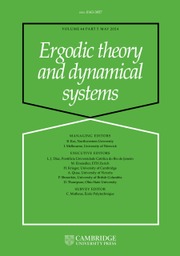No CrossRef data available.
Article contents
 $\overline {d}$-continuity for countable state shifts
$\overline {d}$-continuity for countable state shifts
Published online by Cambridge University Press: 03 October 2025
Abstract
For full shifts on finite alphabets, Coelho and Quas [Criteria for  $\overline {d}$-continuity. Trans. Amer. Math. Soc. 350(8) (1998), 3257–3268] showed that the map that sends a Hölder continuous potential
$\overline {d}$-continuity. Trans. Amer. Math. Soc. 350(8) (1998), 3257–3268] showed that the map that sends a Hölder continuous potential  $\phi $ to its equilibrium state
$\phi $ to its equilibrium state  $\mu _\phi $ is
$\mu _\phi $ is  $\overline {d}$-continuous. We extend this result to the setting of full shifts on countable (infinite) alphabets. As part of the proof, we show that the map that sends a strongly positive recurrent potential to its normalization is continuous for potentials on mixing countable state Markov shifts.
$\overline {d}$-continuous. We extend this result to the setting of full shifts on countable (infinite) alphabets. As part of the proof, we show that the map that sends a strongly positive recurrent potential to its normalization is continuous for potentials on mixing countable state Markov shifts.
MSC classification
Information
- Type
- Original Article
- Information
- Copyright
- © The Author(s), 2025. Published by Cambridge University Press
References
Bhullar, J. and Climenhaga, V.. Continuity in the d-bar metric beyond subshifts of finite type, in preparation.Google Scholar
Buzzi, J. and Sarig, O.. Uniqueness of equilibrium measures for countable Markov shifts and multidimensional piecewise expanding maps. Ergod. Th. & Dynam. Sys. 23 (2003), 1383–1400.10.1017/S0143385703000087CrossRefGoogle Scholar
Climenhaga, V.. Specification and towers in shift spaces. Comm. Math. Phys. 364(2) (2018), 441–504.10.1007/s00220-018-3265-yCrossRefGoogle Scholar
Coelho, Z. and Quas, A. N.. Criteria for
 $\overline{d}$
-continuity. Trans. Amer. Math. Soc. 350(8) (1998), 3257–3268.10.1090/S0002-9947-98-01923-0CrossRefGoogle Scholar
$\overline{d}$
-continuity. Trans. Amer. Math. Soc. 350(8) (1998), 3257–3268.10.1090/S0002-9947-98-01923-0CrossRefGoogle Scholar
Cyr, V. and Sarig, O.. Spectral gap and transience for Ruelle operators on countable Markov shifts. Comm. Math. Phys. 292(3) (2009), 637–666.10.1007/s00220-009-0891-4CrossRefGoogle Scholar
Keane, M.. Strongly mixing
 $g$
-measures. Invent. Math. 16 (1972), 309–324.10.1007/BF01425715CrossRefGoogle Scholar
$g$
-measures. Invent. Math. 16 (1972), 309–324.10.1007/BF01425715CrossRefGoogle Scholar
Mauldin, R. D. and Urbański, M.. Gibbs states on the symbolic space over an infinite alphabet. Israel J. Math. 125 (2001), 93–130.10.1007/BF02773377CrossRefGoogle Scholar
Ornstein, D. S.. An application of ergodic theory to probability theory. Ann. Probab. 1(1) (1973), 43–65.10.1214/aop/1176997024CrossRefGoogle Scholar
Ornstein, D. S.. Ergodic Theory, Randomness, and Dynamical Systems. Yale University Press, New Haven, CT–London, 1974.Google Scholar
Quas, A. N.. Non-ergodicity for
 ${C}^1$
expanding maps and
${C}^1$
expanding maps and
 $g$
-measures. Ergod. Th. & Dynam. Sys. 16(3) (1996), 531–543.10.1017/S0143385700008956CrossRefGoogle Scholar
$g$
-measures. Ergod. Th. & Dynam. Sys. 16(3) (1996), 531–543.10.1017/S0143385700008956CrossRefGoogle Scholar
Rudolph, D. J.. Fundamentals of Measurable Dynamics. Oxford Science Publications; Oxford University Press, New York, 1990.Google Scholar
Sarig, O.. Thermodynamic formalism for null recurrent potentials. Israel J. Math. 121 (2001), 285–311.10.1007/BF02802508CrossRefGoogle Scholar
Sarig, O. M.. Thermodynamic formalism for countable Markov shifts. Ergod. Th. & Dynam. Sys. 19(6) (1999), 1565–1593.10.1017/S0143385799146820CrossRefGoogle Scholar
Walters, P.. Ruelle’s operator theorem and
 $g$
-measures. Trans. Amer. Math. Soc. 214 (1975), 375–387.Google Scholar
$g$
-measures. Trans. Amer. Math. Soc. 214 (1975), 375–387.Google Scholar


